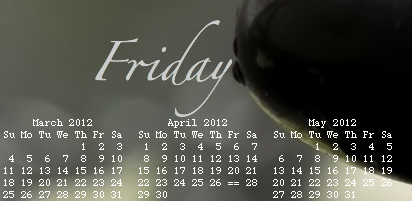

La Mojarra Stela 1, the Tuxtla Statuette, Tres Zapotes Stela C, and Chiapa Stela 2 are all inscribed in an Epi-Olmec, not Maya, style. Of the 6 sites, three are on the western edge of the Maya homeland and three are several hundred kilometers further west, leading most researchers to believe that the Long Count calendar predates the Maya. This table lists the 6 artifacts with the 8 oldest Long Count dates. The earliest Long Count inscription yet discovered is on Stela 2 at Chiapa de Corzo, Chiapas, Mexico, showing a date of 36 BC.
#GEEKTOOL LONG CALENDAR FULL#
The text then continues with whatever activity occurred on that date.Ī drawing of a full Maya Long Count inscription is shown below ( click here). The date is concluded by a glyph stating the day and month of the Haab year.
#GEEKTOOL LONG CALENDAR SERIES#
Most of this supplementary series is optional and has been shown to be related to lunar data, for example, the age of the moon on the day and the calculated length of current lunation. Next come the 5 digits of the Long Count, followed by the tzolk'in date written as single gylph, and then by supplementary information. The date sequence is given once, at the beginning of the inscription, and opens with the so-called ISIG (Introductory Series Initial Glyph) which reads tzik-a(h) hab’ ("revered was the year-count with the patron "). On Maya monuments, the Long Count syntax is more complex. The date on Stela C, then, is 1,125,698 days from AugBC, or September 1, 32 BC. As can be seen at left, the Long Count date shown on Stela C at Tres Zapotes is 7.16.6.16.18. b'ak'tun) on the top and then the number of each successively smaller order periods until the number of days ( k'in) are listed. The Long Count dates are written vertically, with the higher periods (i.e. The glyphs surrounding the date are what is thought to be one of the few surviving examples of Epi-Olmec script. The numerals 7.16.6.16.18 translate to September 1, 32 BC (Gregorian). This is the second oldest Long Count date yet discovered. The back of Stela C from Tres Zapotes, an Olmec archaeological site. See also History of zero File:Tres Zapotes Stela.C. The Long Count calendar required the use of zero as a place-holder, and presents one of the earliest uses of the zero concept in history. The shell glyph was used to represent the zero concept. A dot represents one while a bar equals 5. Long Count dates are written with Mesoamerican numerals, as shown on this table. There are also four rarely-used higher-order periods: piktun, kalabtun, k'inchiltun, and alautun.Ĭalculating Long Count dates File:Maya.svg Eighteen winals or 360 k'in make one tun. Twenty of these k'ins are known as a winal (or uinal). The following table shows the period equivalents as well as Mayan names for these periods. Thus 0.0.1.0.0 does not represent 400 days, but rather only 360 days. The Long Count is not consistently base-20, however, since the second digit (from the right) only counts to 18 before resetting to zero. Rather than using a base-10 scheme, like Western numbering, the Long Count days were tallied in a base-20 scheme. The Long Count calendar identifies a date by counting the number of days from AugBC. To measure dates over periods longer than 52 years, the Mesoamericans devised the Long Count calendar. This period was known as a Calendar Round. The combination of a Haab' date and a Tzolk'in date was enough to identify a specific date to most people's satisfaction, as such a combination did not occur again for another 52 years, above general life expectancy.īecause the two calendars were based on 365 days and 260 days respectively, the whole cycle would repeat itself every 52 Haab' years exactly. The Haab' and the Tzolk'in calendars identified and named the days, but not the years. This 260-day calendar was known as the Tzolk'in to the Maya and tonalpohualli to the Aztecs. 7.1 Calculating the Tzolk'in date portionĪmong other calendars devised in pre-Hispanic Mesoamerica, two of the most widely used were the 365-day solar calendar ( Haab' in Mayan) and the 260-day ceremonial calendar, which had 20 periods of 13 days.

5 Correlations between Western calendars and the Long Count calendar.


 0 kommentar(er)
0 kommentar(er)
